|
|
||
|
BETULA utilis subsp. albosinensis
'Bowling
Green'
This selection traces back to the original Wilson 4106 collection from W. Sichuan, China. The original tree is now dead, but it grew adjacent to the Bowling Green at Werrington Park, Cornwall. The rich chestnut outer bark peels to reveal a paler silvery under layer. The buds are similarly coloured and catkins are freely produced. It is naturally free branching, the trunks typically remaining slender. However, it does seem that this is not the most accommodating cultivar to grow in cultivation. |
||
|
|
||
| BETULA
utilis subsp.
albosinensis
'China Rose' There have been a number of cultivars selected from seed collected from Gansu, most of which feature bark colours more to the red end of the range typical for this subspecies and this is no exception. |
||
|
|
||
| BETULA
utilis subsp.
albosinensis
var. septentrionalis 'China Ruby' This cultivar name was given to a tree at Hillier's West Hill Nursery in Hampshire that is thought to have been a Wilson collection. In my experience here it is considerably less vigorous than the species, so eminently suited to small gardens, this can be a very dramatic tree once established. The rich pink bark can appear almost scarlet when wet. This then peels to reveal creamy-white under-bark that is tinged with grey and pink. The leaves are a rather bluish green, whilst the twigs are much more “warty” than is usual. |
||
|
|
||
 |
BETULA
utilis subsp.
albosinensis
'Chinese Garden' Reputedly from the same batch of seed as ‘Bowling Green’, this one is much better behaved. The rich pinkish- chestnut bark is even darker than that of ‘Bowling Green’, with less contrast between the different layers giving a more consistent visual effect. By comparison the overall habit is squatter than 'Bowling Green', but just as free branching. Apparently, although its introduction dates back to 1910, this clone wasn’t actually named until some 80 years later. |
|
|
|
||
| BETULA
utilis subsp.
albosinensis 'Cobhay Gansu Red' This is our own selection from see collected in Gansu, China. With time this one develops lovely red tints through its bark. |
||
|
|
||
| BETULA
utilis subsp.
albosinensis 'E. Eider' This one came to us from Sweden, where it was selected for supreme hardiness and bark colour. And so it stands out in our collection (though hardiness is not a relevant concern in this country) not only for the rich orange-pink-mahogany colours that are so hard to describe, but for its size and habit too. It has proven to be distinctly upright in habit and rather more compact than most. |
||
|
|
||
| BETULA
utilis subsp.
albosinensis
'Joseph Rock' Another wonderful selection from Sweden, this cultivar really does stand out. As the tree matures, the bark effect becomes increasingly purple, a unique colour in our collection. It is also considerably taller and more upright than any other, typically making a very elegant and slender multi-stemmed tree. |
||
|
|
||
 |
BETULA
utilis subsp.
albosinensis
var. septentrionalis 'Kansu' Another of the Gansu wild collections, this selection has particularly good vigour and has become a "stand out" tree in our collection. The bark becomes shades of copper and pink, overlaid with a distinct bloom. |
|
|
|
||
 |
BETULA
utilis subsp.
albosinensis
'Kenneth Ashburner' A vigorous, upright selection. The cinnamon coloured bark peels to reveal a pinky red under layer which is initially covered in a white bloom, giving a silvery pink effect. |
|
|
|
||
 |
BETULA
utilis subsp.
albosinensis
'Ness'
(Clone F) This is another of the richly coloured selections originating from Gansu in China. The gorgeous chestnut bark peels to reveal a rich pink under-layer beneath the ghostly white bloom. |
 |
|
|
||
| BETULA
utilis subsp.
albosinensis
'Pink Champagne' Also from the Ness Gardens seedlings, this selection from seed collected by the Chinese Forestry Service in the Gansu province of China really stands out amongst its peers. The bark becomes an intoxicating orangey-pink...so hard to describe, but paling beneath a white bloom of betulin over the surface. This clone typically branches freely to create a wonderful symmetrical structure. The foliage is distinctive too, being more heavily textures and a rich deep green. One of my favourites. |
||
|
|
||
| BETULA
utilis subsp.
albosinensis
var. septentrionalis 'Purdom' 752 This graceful tree develops a light airy canopy (great for under-planting). The deep maroon-pink bark has a blue-white bloom. I find this selection to be much smaller and slower growing than the others. In fact, I'm inclined to describe it as "weaker" which goes some way to explaining why it's rarely available! |
||
|
|
||
| BETULA
utilis subsp.
albosinensis
'Red Panda' These plants are derived from the spectacular specimen growing at Wisley RHS Garden. I understand that the original seed was collected in the early nineties by Steve Sponberg as part of a Sino / American expedition, from the Shennongjia national park in Hubei, China. It was named by Jim Gardiner, then curator at Wisley, after the red pandas who inhabit that locality, with an oblique reference to the bark colour. |
||